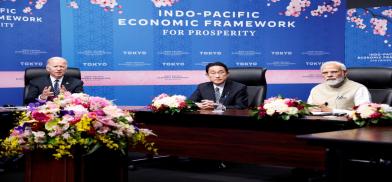India's pivot to Indo-Pacific is harbinger of geo-economic shifts in trade priorities
The US has now become important for India’s energy security as is the United Arab Emirates, Saudi Arabia and Iraq, writes N. Chandra Mohan for South Asia Monitor

India achieved its ambitious target for exports of $422 billion with two-way trade of $1 trillion in 2021-22, reflecting a focused drive of the commerce ministry in fixing targets for top markets and regular meetings with stakeholders and overseas missions. Indicative of shifts in trade priorities, the US has now become the country’s largest trading partner with bilateral trade of $119.4 billion, followed by China ($115.4 billion), the United Arab Emirates ($72.9 billion), Saudi Arabia ($42.8 billion) and Iraq ($34.3 billion).
The numero uno status of the US points to strengthening ties between the two nations amidst signs of lesser dependence on China due to the ongoing faceoff on the Sino-Indian border. The US has now become important for India’s energy security as is the UAE, Saudi Arabia and Iraq.
India’s trade drive is also bolstered by free trade agreements, including the prospect of signing deep agreements as with the UK by the yearend. A comprehensive economic partnership agreement with the UAE (negotiated in double-quick time) and an Economic Cooperation and Trade Agreement with Australia have also been recently signed. Several other deals are currently under negotiation, with pacts with the Gulf Cooperation Council, Canada and European Union being fast-tracked.
India has also recently decided to join the US-led Indo-Pacific Economic Framework (IPEF), along with 12 other countries, marking its return back to that region after exiting from the Sino-centric Regional Comprehensive Economic Partnership (RCEP) literally at the eleventh hour.
More FTAs with like-minded nations
India is emerging as a trusted partner of the US and other developed nations which are reducing their supply-chain dependence on China. As the fastest growing economy in the world, with a large domestic market, the attractions of diversifying their business to India are considerable. India, for its part, has expressed its willingness to enter into robust FTAs with like-minded nations with values of democracy, transparency and mutual growth and not just to be a part of any group.
This new stance reflects its ambivalence over the benefits of earlier deals signed with the Association of Southeast Asian Nations, Japan and South Korea and other countries which have only resulted in large trade deficits. India has registered a huge deficit of $25.7 billion with ASEAN in 2021-22.
The latest trade numbers also indicate why India has pivoted to the Indo-Pacific. Its two-way trade with RCEP, which comprises ASEAN, China, Japan, South Korea, Australia and New Zealand, amounts to just under $300 billion entailing a massive imbalance of $124.6 billion. This is largely due to India’s growing deficit with China of $72.91 billion in 2021-22, which has coloured its view of other FTAs that it signed as trade deals with China by stealth.
In sharp contrast, there are relatively greater comfort levels in trading with the US with which India enjoys a trade surplus of $32.8 billion. Although the IPEF is only a putative bloc, the relatively greater attractions for India are that its two–way trade is similar to that of RCEP with a smaller deficit of $18.8 billion.
More engagement with IPEF
That being said, the IPEF is unlikely to be another word for the Trans-Pacific Partnership from which the US walked out under the previous Donald Trump Administration or its new incarnation as the Comprehensive and Progressive Agreement for Trans-Pacific Partnership as there is no bipartisan consensus in US Congress on providing market access or tariff reductions. Last year, US President Joseph Biden mentioned IPEF at the East Asia summit stating that it will define shared objectives on trade facilitation, standards for the digital economy and technology, supply chain resilience, decarbonization and clean energy, infrastructure and worker standards. India might not be on the same page on digital commerce and labour standards, for instance. India, for its part, reaffirmed that it will work with partners to build an inclusive and flexible IPEF.
Nevertheless, India’s decision to engage with the IPEF has to factor in the fact that the level of ambition for a potential FTA is likely to be equivalent to that of CPTPP or the RCEP. This is only to be expected as eight members of the IPEF (Australia, Brunei, Japan, Malaysia, New Zealand, the Philippines, Singapore and Vietnam) are also part of the CPTPP and as many as 11 are also part of RCEP which has already come into force on January. In this regard, a major positive for India is its ECTA with Australia, which was hailed as a “watershed moment” by India’s Prime Minister Narendra Modi.
As Australia is a member of both CPTPP and RCEP, greater comfort levels in implementing the ECTA may well incentivize India to raise its level of ambition for deeper trade and economic engagements with the IPEF grouping. India’s booming trade with the US, which is likely to continue in the future as well, is a harbinger of geo-economic shifts in trade priorities towards the prosperous Indo-Pacific region.
(The writer is an economics and business commentator based in New Delhi. His views are personal. He may be contacted at nchandramohan@rediffmail.com)










Post a Comment